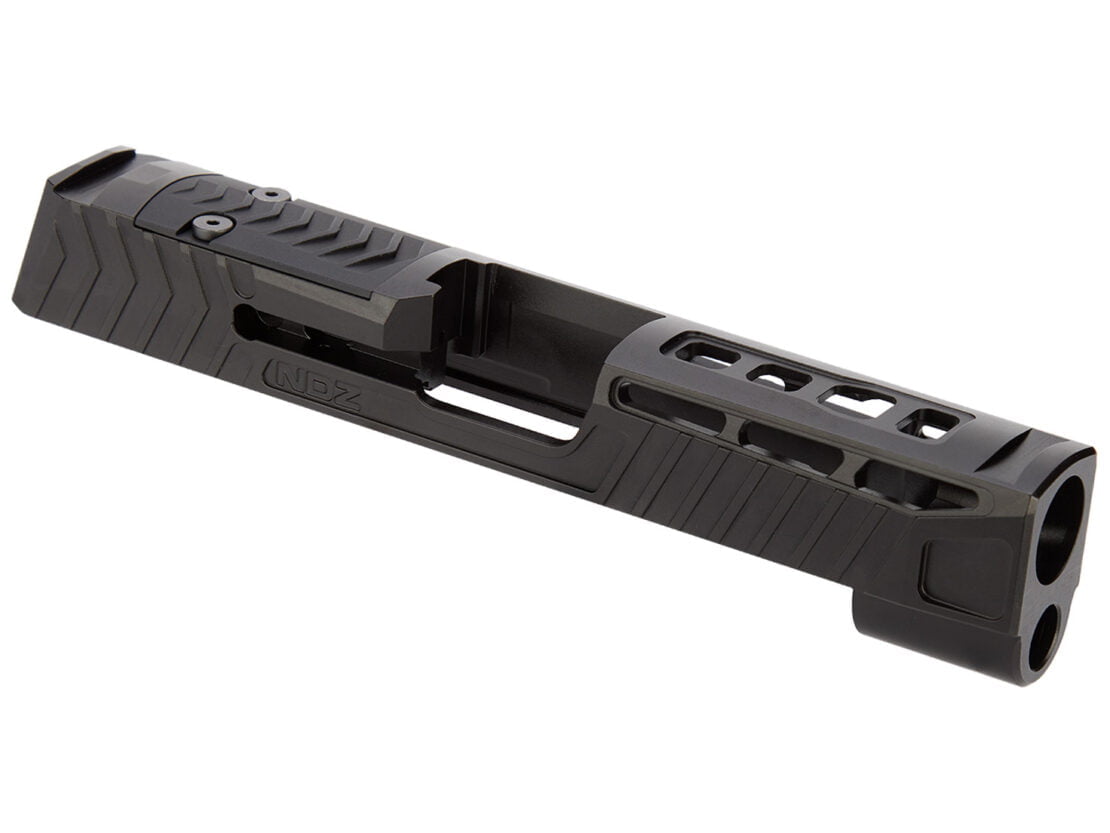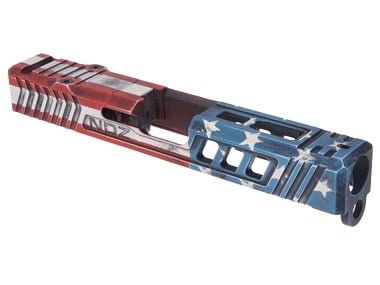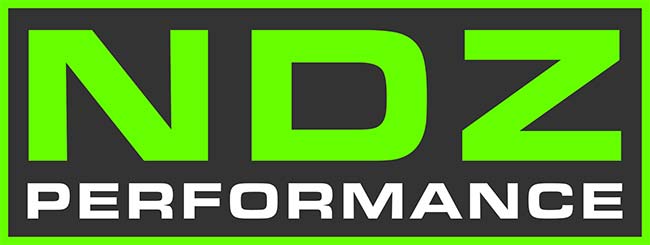Estimated reading time: 8 minutes
Firearms enthusiasts, welcome to another edition of our blog series where we delve into the world of firearm coatings and treatments! Today, we’re comparing two popular methods that can significantly enhance both the performance and appearance of your firearms: Cerakote and QPQ Black Nitride. Whether you’re looking to improve durability, corrosion resistance, or simply want to customize the look of your firearm, understanding these two distinct coating processes will help you make an informed decision for your specific needs.

In Black Nitride
Product Code: NDZ-SLD-P365XL-TROI-RMSC-BN
$349.99
What is QPQ Black Nitride firearm coating?
QPQ stands for Quench-Polish-Quench, a sophisticated surface treatment process that fundamentally improves the base material by simultaneously hardening and buffing the surface. This multi-stage process significantly enhances rust resistance and other critical performance factors of various metals. Also referred to as Melonite or Tennifer in some circles, QPQ treatment dramatically improves wear resistance, reduces friction by increasing lubricity, and enhances visual appeal while increasing fatigue resistance of treated components. Due to its rich satin black color and exceptional performance characteristics, QPQ Black Nitride has become a very popular finish in the firearm industry for both steel and stainless steel components.
Understanding Q vs. QP vs. QPQ Nitride Processes
To fully appreciate the QPQ Black Nitride process, it’s helpful to understand the terminology and the evolution of nitride treatment techniques:
Q (Quench): The single “Q” process refers to the basic nitriding process followed by a quenching step. During this initial stage, the metal component is heated in a salt bath containing nitrogen compounds. As a result, the nitrogen diffuses into the metal surface, creating a hardened layer. The component is then rapidly cooled (quenched) to stabilize the newly formed nitride layer. While effective at creating hardness, nevertheless, the single Q process often leaves a porous, somewhat rough surface that may still be vulnerable to corrosion.
QP (Quench-Polish): The QP process adds a critical polishing step after the initial quenching. Consequently, this polishing removes the porous outer layer (sometimes called the “white layer”) that forms during nitriding. The result is a smoother surface with improved appearance and reduced friction. However, the QP process only addresses the surface characteristics and doesn’t fully optimize the corrosion resistance properties of the treated metal.
QPQ (Quench-Polish-Quench): The full QPQ process represents the most advanced and complete nitriding treatment. After the initial quenching and polishing steps, therefore, the component undergoes a second quenching procedure in an oxidizing salt bath. This final step creates a magnetite (Fe3O4) layer that significantly enhances corrosion resistance while maintaining the hardness and reduced friction achieved in earlier steps. As a result, the QPQ process produces the optimal combination of hardness, wear resistance, friction reduction, and corrosion protection – making it the preferred choice for high-performance firearm components.
Evolution of Nitriding Technology
The evolution from Q to QP to QPQ represents significant advancements in the science of metal treatment, with each additional step addressing limitations of the previous process. Initially, simple nitriding provided basic hardening. Subsequently, the addition of polishing improved surface quality. Finally, the complete QPQ treatment offers a comprehensive enhancement of the metal’s properties, explaining its popularity in the firearms industry where components must withstand harsh conditions while maintaining precise functionality.
Tech Sheet: BlackNitride+™, or Ferritic Nitrocarburizing, is a thermochemical process that simultaneously diffuses nitrogen and carbon into the surface of ferrous metals. During the process, a two-part surface layer is formed: an outer iron nitride layer with a nitrogen diffusion layer below it. Nitrogen and carbon are absorbed by and diffused into the surface of the metal. Reproducible and uniform layers with predetermined thickness will be formed on all areas of the metal. This process results in markedly improved surface properties on ferrous metal parts while maintaining dimensional and shape stability. Blacknitride+™ is commonly used as an alternative to high-temperature conventional heat treatments such as carburizing and carbonitriding.
The Science Behind QPQ Black Nitride
The effectiveness of QPQ Black Nitride comes from its ability to actually alter the molecular structure of the metal’s surface rather than simply coating it. During the nitriding process, nitrogen atoms diffuse into the metal to form hard nitride compounds with the iron and other alloying elements present in the steel. This creates a case-hardened layer that typically ranges from 0.004″ to 0.012″ in depth, depending on the process parameters and base metal composition.
Performance Characteristics
The resulting surface hardness can reach up to 70 HRC (Hardness Rockwell C), significantly higher than the core hardness of most steels. This exceptional surface hardness, combined with the inherent lubricity of the nitride layer, provides outstanding wear resistance even under extreme conditions. In addition, the second quenching stage in the QPQ process creates an oxide layer that fills the micropores of the nitride layer, further enhancing the corrosion resistance properties.
Advantages of QPQ Black Nitride
Real-World Performance Benefits
Firearms treated with QPQ Black Nitride demonstrate several practical advantages in the field:
Extended Barrel Life: The increased surface hardness significantly reduces bore erosion, especially in high-volume shooting scenarios.
Improved Cycling Reliability: Due to reduced friction between sliding parts, operation becomes smoother with fewer malfunctions.
Cold Weather Performance: Thanks to the inherent lubricity of the nitride surface, firearms remain operational at lower temperatures, even with reduced lubrication.
Corrosion Resistance: Moreover, QPQ-treated firearms show excellent resistance to rust even when exposed to saltwater, humidity, or body sweat during concealed carry.
Limitations of QPQ Black Nitride
Applications Beyond Firearms
QPQ Black Nitride firearm coating works primarily on ferrous materials like carbon steels, alloy steels, tool steels, structural steels, and cast iron. Beyond firearms, its applications extend into automotive manufacturing, oil and gas extraction, construction equipment, and other industrial settings. Components frequently enhanced with QPQ treatment include hydraulic valves, gears, brake rotors, cutting tools, and drill bits – all applications where wear resistance and durability are essential.
At NDZ, we offer a wide selection of products pre-treated with QPQ Black Nitride for increased durability and performance across various firearm platforms.
What is Cerakote firearm coating?

Product Code: NDZ-SLD-GL19G3-V1-RMR-PAT10-RP
$449.99
Unlike QPQ Black Nitride, Cerakote represents a fundamentally different approach to firearm enhancement. Rather than altering the metal’s molecular structure, Cerakote is a ceramic-based polymer coating applied to surfaces like firearms and knives. Its remarkable durability stems from a unique chemical composition that combines ceramic particles in a polymer matrix, creating a thin yet incredibly resilient layer. With proper care, furthermore, Cerakote can last for years on both metal and polymer surfaces, maintaining its protective qualities and appearance.
The Cerakote Application Process
The Cerakote application process involves several critical steps that contribute to its exceptional performance:
1. Surface Preparation: First, the substrate must be thoroughly cleaned and often bead-blasted to remove contaminants and create an optimal surface for adhesion.
2. Degreasing: Next, all oils and residual contaminants are removed using specialized solvents to ensure perfect bonding between the coating and substrate.
3. Application: Subsequently, the Cerakote formula is applied using a professional-grade HVLP spray gun to achieve the optimal thickness of approximately 0.001″ (1 mil).
4. Curing: Finally, depending on the specific formula used, the coated components are cured either at room temperature or in an oven at temperatures ranging from 250°F to 300°F for 1-2 hours.
This multi-step process creates a hard ceramic coat layer that offers exceptional corrosion and abrasion resistance. However, the complete application cycle can take anywhere from a few days to over a week, depending on workflow and project complexity.
The Science Behind Cerakote
Cerakote’s performance comes from its hybrid ceramic-polymer composition. On one hand, the ceramic components provide hardness and heat resistance. On the other hand, the polymer matrix offers flexibility and excellent adhesion. The specific formulations are proprietary, but generally contain:
Ceramic particles: These provide hardness, abrasion resistance, and heat dissipation
Resin systems: Meanwhile, these create the polymer matrix that binds the ceramic particles
Pigments: Additionally, these provide color and UV resistance
Solvents: Finally, these allow for proper application viscosity and promote curing
Protective Properties
This specialized combination creates a coating typically only 0.001″ thick yet offering protection far beyond expectations for such a thin layer. In particular, the ceramic components create a barrier against chemicals, moisture, and abrasion, while the polymer elements provide flexibility that prevents cracking or chipping under impact or when the substrate flexes.
Advantages of Cerakote
Real-World Performance Benefits
Firearms treated with Cerakote offer several practical advantages in real-world use:
Enhanced Concealed Carry Comfort: Firstly, the smooth, low-friction surface makes drawing from holsters smoother while reducing clothing wear.
Reduced Visual Signature: Additionally, custom colors and patterns allow for improved camouflage in specific environments.
Improved Heat Management: Furthermore, Cerakote can reduce heat transfer from barrels to handguards during rapid fire.
Personalization: Finally, custom colors and patterns make identification of personal firearms easier in group settings.
Disadvantages of Cerakote
Cerakote Product Offerings
At NDZ, we provide a wide range of products with premium Cerakote finishes. For instance, our NDZ T.R.O.I. Slide Upgrade For Glock 19 Gen 1-3 With RMR Cut And Plate In Battle Worn Red White & Blue US Flag Cerakote offers both enhanced protection and distinctive aesthetic appeal for those seeking personalization.
Comparing Cerakote and QPQ Black Nitride Side by Side
To help you make an informed decision, here’s a direct comparison of these two popular firearm treatments across key performance categories:
| Feature | QPQ Black Nitride | Cerakote |
|---|---|---|
| Process Type | Thermochemical diffusion process | Ceramic-polymer coating |
| Material Compatibility | Ferrous metals only | Almost any substrate |
| Thickness | 0.004″ to 0.012″ case depth | About 0.001″ coating thickness |
| Hardness | Up to 70 HRC surface hardness | 70-78 Pencil Hardness (different scale) |
| Corrosion Protection | Excellent (up to 72 hours in salt spray) | Superior (over 3,000 hours in salt spray) |
| Wear Resistance | Excellent for moving parts | Good, with potential wear at friction points |
| Heat Tolerance | Up to 1000°F | Up to 500°F depending on formula |
| Color Options | Primarily black with limited variations | Over 350 colors plus custom patterns |
| Application Method | Salt bath immersion process | HVLP spray application |
| Dimensional Impact | Negligible changes | Adds roughly 0.001″ to dimensions |
| Surface Coverage | Treats internal and external surfaces | Primarily external surfaces |
| Friction Reduction | Significant coefficient reduction | Moderate coefficient reduction |
| Cost Range | Moderate to high | Varies from low to very high |
| Best Applications | Barrels, slides, internal components | External parts, customization projects |
Making Your Choice: Factors to Consider
WHICH FIREARM COATING IS RIGHT FOR YOU, CERAKOTE OR QPQ BLACK NITRIDE?
Performance Priorities
So, which one should you choose? Well, it largely depends on your specific needs and priorities.
QPQ: Ideal for Performance Enhancement
If you’re primarily focused on enhancing performance—particularly wear resistance, heat resistance, and reduced friction between moving parts—QPQ Black Nitride likely represents your best option. This thermochemical process creates a modified surface layer that integrates with the metal itself rather than adding a separate coating. As a result, it works exceptionally well for high-stress components like barrels, bolt carriers, and slides. Moreover, QPQ treatment excels in firearms that will see high round counts or demanding conditions.
Cerakote: Ideal for Customization
Conversely, if aesthetic customization and maximum corrosion protection matter more to you, Cerakote offers distinct advantages. With its extensive color palette and ability to create complex patterns, Cerakote enables unprecedented personalization. Additionally, its exceptional chemical and corrosion resistance makes it valuable for firearms exposed to harsh environments, saltwater, or body sweat during carry. Furthermore, since Cerakote adheres to virtually any material, it remains the only viable option for polymer frames, wood stocks, and non-ferrous components.
The Combined Approach
For many enthusiasts, the ideal solution involves combining both treatments. For example, you might consider using QPQ Black Nitride for internal steel components and barrels to maximize wear resistance and performance. Meanwhile, you could apply Cerakote to external surfaces for superior corrosion protection and aesthetic customization. Through this approach, you can leverage the strengths of both processes to create a firearm that not only performs optimally but also looks exactly how you want it to.
In Conclusion
The choice between Cerakote and QPQ Black Nitride ultimately depends on understanding your specific requirements and priorities. Both treatments offer unique benefits that can significantly enhance your firearm’s performance, longevity, and appearance.
For performance enhancement, wear resistance, and friction reduction, QPQ Black Nitride provides hard-to-match advantages. Alternatively, for maximum corrosion protection, customization options, and versatility across materials, Cerakote delivers exceptional capabilities.
If you’re still uncertain about which treatment would best serve your needs, therefore, our experts at NDZ Performance can help you make an informed decision. Visit our product pages to explore our range of QPQ Black Nitride and Cerakote treated products. Each one provides an optimal balance of performance and aesthetics for different applications.
Don’t forget to follow us for more informative articles on firearm maintenance, product reviews, and tips. Additionally, stay tuned for our next blog post where we’ll explore specialized applications for these coating technologies!
This article aims to inform and should not replace professional advice. Always consult with a qualified expert when selecting treatments for your firearms.
Stay Safe While Upgrading
Upgrades boost performance, but safety comes first. We urge all gun owners to review safety basics often. For trusted safety info, visit the NSSF's Safety Resources.
Also consider taking a class to get the most from your upgraded gun. Good training helps you use your better RXM safely and effectively.
Connect With Our Community
Join thousands of NDZ customers on social media. Share your builds, ask questions, and see what others create. Follow us for tips, deals, and new product alerts.
Questions? We're Here to Help
We want your upgrade journey to be fun and rewarding. Our guide walks you through every step, but we know questions come up during builds.
Need specific advice? Comment on the video or email our team at Sales@ndzperformance.com. Don't forget to like and subscribe for more content.
Your upgrade starts here with NDZ. Experience the difference quality parts make in your shooting!
